Isn’t it the absolute worst when you get a bump email and it says:
“Just bumping this up your list. Let me know what you think.”
How often do you reply to these kinds of follow up messages? I don’t know about you, but frankly, I ignore them.
And sadly, many sales teams make this mistake when it comes to a lead follow-up. They send follow ups that add no value whatsoever to the reader.
This is why effective lead follow ups are so important.
After spending a ton of time building a killer prospect list and crafting the perfect email, you don’t want to decrease your chances of landing a sale by sending a “subpar” follow up.
So, keep reading if you want our lead per day follow up recipe and some expert tips that will boost sales.
(Side note: These examples will be from the viewpoint of following up with a sales lead who has shown interest in your product or service.)
Interested in a free 15-minute strategy session with the founder of Salesbread, Jack Reamer? Just go here.
What is a lead follow up?
There is a discrepancy in how we define leads.
Unfortunately, a lot of us think of leads as potential clients or customers. And yet, the true definition of a lead, is a prospect that matches your ICP criteria AND who has expressed some form of interest in your services; This will ensure that they are prioritized over cold prospects on your list.
So, depending on whether you’re reaching out to cold or warm leads, your strategy will differ slightly.
Way 1: Following up with COLD prospects
In our books, we don’t call cold prospects leads. But for interest’s sake, let’s say you would like to know how to follow up with a cold prospect.
If this is the case, you need to follow up using more than one channel. We loved using LinkedIn outreach.
But we know that sometimes it’s also helpful to reach out with a nicely personalized email.
At times, it might even be helpful to pick up the phone and call sales leads as a follow-up step; Granted we don’t suggest doing this for every prospect because it would take way too much time.
We suggest adding a phone step if you see that the prospect has opened your email newsletter a couple of times and that they are engaging with your social media posts or content.
This shows interest. A phone step might just nudge them in the right direction.
Way 2: Following up with WARM leads
We will discuss this in greater detail below, so keep reading.
Best lead follow-up strategies & best practices
1. Use personalization for effective lead follow-ups
Sending a follow up sales email or LinkedIn outreach message with no personalization is a big no-no.
If you want effective follow ups, you need to use personalization so that your prospects know they aren’t just a number on a list.
Personalization also shows your potential clients that you have done your homework and this makes your messages stand out from every other salesperson.
At SalesBread, we always suggest a customized intro based on research of the prospect.
Here’s an example:
{Name}, Thanks for connecting. By the way, I see that you’re an avid hiker, been to any good hiking spots these days?
You can then continue with your pitch with the tips that we offer below.
2. Keep your lead follow-up short & simple
The most common mistake when following up with a lead is overloading them with too much information.
Would you rather read this:
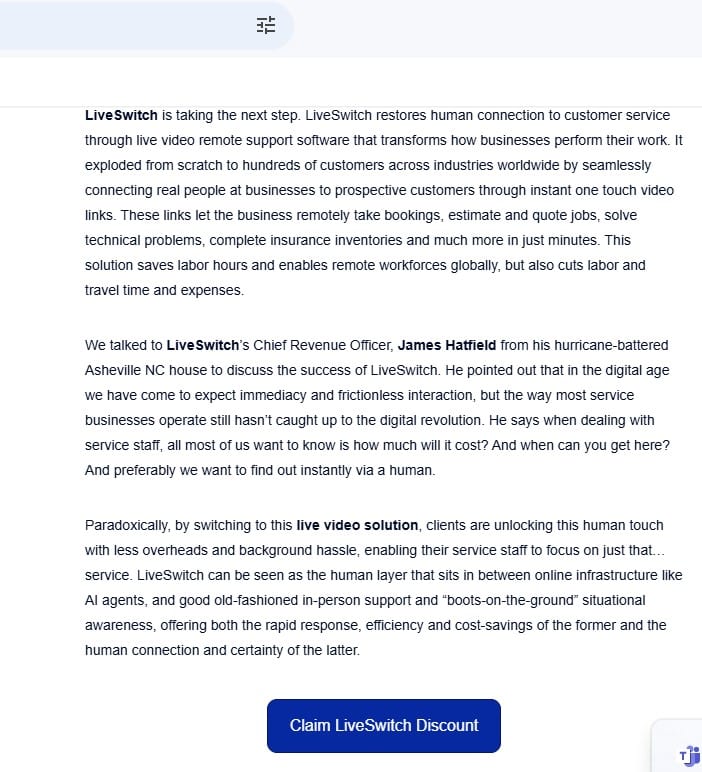
Or this:
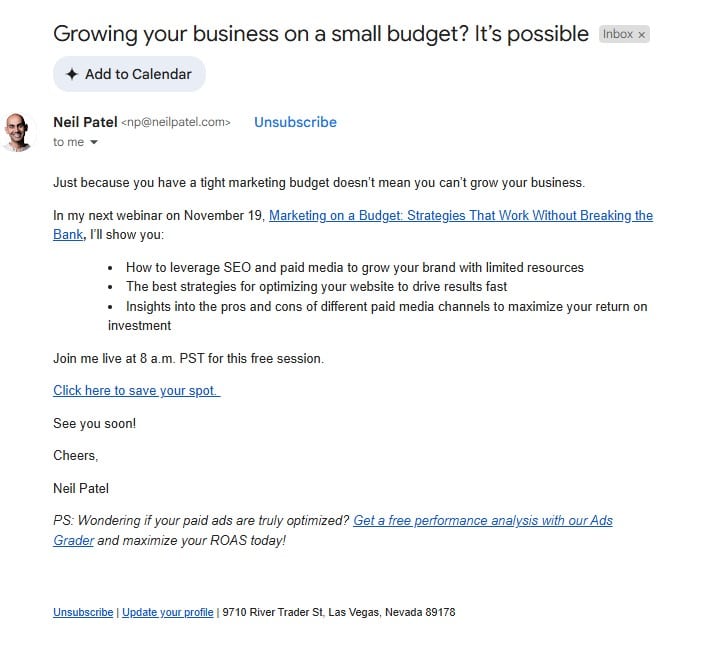
I’m betting that you would most probably prefer reading the second email just because it’s short and to the point. There isn’t a ton of text to wade through to figure out the point of the email.
So avoid sending long emails or LinkedIn outreach messages that are packed with links, attachments, or lengthy explanations.
Once, we had someone tell us that they asked Chat GPT to summarize their website into a cold email, and it spat out a ton of paragraphs.
This is not the right way to send an effective lead follow up. You’re just going to confuse the prospective client, and in all honesty, who has time to read a 500 word email?
No one.
Instead, consider your follow-up an extension of your initial cold message: concise, focused, and geared toward moving them to the next step.
The goal is to keep the prospect’s interest, not overwhelm them.
Here’s an example:
{Name}, it’s good to connect. {custom intro sentence}
After seeing your approach for {end_result}, I’m curious to know if you have ever had {goal} in mind?
If so, can you tell me more about it? Would love to see if my company could help in any way.
Quick Tip :
Resist the urge to explain everything. Rather, keep the interaction simple and enticing. For example, offer a brief snippet or ask a targeted question to maintain momentum without overwhelming your prospect.
2. Ask a Targeted Question to Gauge Their Interests
An ideal response to an “I’m interested” email is a question that narrows down the prospect’s specific interests. This step not only makes it easier for you to customize your approach but also shows the prospect that you’re attentive to their unique needs.
Example Follow-Up :
“Happy to share more! Can you let me know if you’re more interested in learning about our product’s features or how it can solve specific problems? That way, I can provide the most relevant info.”
This approach prevents the prospect from feeling like they’re in an impersonal sales funnel, allowing you to tailor your pitch based on their response.
3. Qualify and Direct the Conversation Toward the Right Next Step
Once you get an indication of their interest, the next step could be a call, but make sure it’s appropriate. Qualifying questions help determine if the lead aligns well with your offering and helps you set up a meeting tailored to their needs.
Example Follow-Up :
“Great to hear you’re interested! Before we jump on a call, could you let me know a couple of things about your current setup? This will help me prepare the best information for our chat.”
This technique shows that you value their time and want to deliver meaningful insights rather than pitch blindly.
4. Use Follow-Ups with a Variety of Touchpoints

If they don’t respond after your first follow-up, don’t give up. It’s important not to presume that your prospect isn’t interested.
Therefore, a sequence of varied follow-ups is often necessary to keep the lead engaged without pushing them away.
At SalesBread, we like using the Fibonacci sequence.
The Fibonacci sequence is a series of numbers in which each number is the sum of the two preceding ones, starting from 0 and 1 (i.e., 0, 1, 1, 2, 3, 5, 8, 13, etc).
When applied to sales, this sequence can help structure follow-up timing with leads. Instead of checking in daily or weekly, you might space out follow-ups based on this pattern.
For example, you could reach out to a lead on the 1st day, then 2 days later, then 3 days after that, and so on, progressively spacing out your touchpoints.
This approach creates consistent but not overwhelming follow-ups , respecting the customer’s time while keeping your business top-of-mind, thus helping to build trust and identify leads that show real interest in what you’re selling.
You could then also alternate between emails, phone calls, or even offer short, digestible content, like a one-minute demo video or a quick slide deck. Think of these as “movie trailers” to maintain their interest without giving away the full presentation.
Example Follow-Up :
“While we wait to connect, here’s a 60-second video highlighting how our solution can benefit companies like yours. Let me know if this speaks to your goals, and we can set up a time to chat!”
This approach subtly builds interest while making the follow-up feel valuable and relevant.
5. Offer a Choice, Not an Open-Ended Question
Instead of asking, “Would you like to take the next step?” give them options that make it easy to decide. You could give them 3 options and then ask them to respond with what works best for them.
You could even say reply 1, and I will get started on that option for you.
Make it as easy as possible for your prospect to respond, and you can do this by being specific. A clear CTA helps with this.
Example Follow-Up :
“Awesome, the next step is typically one of these: We can either:
-
Schedule a quick call, or
-
I can send over a personalized demo.
Which would you prefer?”
By offering clear options, you simplify the decision process for them and nudge them toward continuing the conversation.
6. Show Confidence and Lead the Process
You’re the expert in this interaction, so take ownership of the process.
Lay out the steps in a confident, structured way, so the prospect feels they’re in capable hands. As we mentioned above, don’t presume that they aren’t interested.
Remember, if you have done your research properly and your product/service can really benefit this individual, show your confidence in it.
Example Follow-Up :
“Our process typically involves a quick intro call, a tailored demo, and then we work together on an action plan. Let’s start with the call—what day works for you?”
Mapping out the process helps the lead feel guided, reducing any hesitation they may have.
7. Don’t Give Up— Persistence is Key During the Sales Process
Many leads get busy and don’t respond immediately, even if they’re genuinely interested. Perhaps the timing wasn’t right just yet, so if you retarget the lead a few months from now, they might actually be in the right space to buy.
So we suggest following up until they clearly say they’re not interested or ask you to stop.
Multi-channel follow-ups (such as email and phone) can make all the difference. Be persistent yet respectful, and always keep the follow-ups short and value-oriented.
Pro Tip: If you’re unsure, set a mental marker to follow up until you get a clear response. That way, you’ll know you’ve given every effort to convert this lead.
8. Use automation with caution
We noticed that many articles discussing follow-ups say you should use automation.
And yes, using automation for sales follow ups is beautiful when done correctly because it’s so powerful; and yet automation can run wild and actually mess up your entire strategy when done the wrong way.
It has to be used with caution.
If you send too many messages via automation, it can really backfire., especially if you’re sending follow ups that aren’t relevant to that prospect.
We suggest using automation BUT you have to make sure that you have enough custom placeholders in your email or LinkedIn messages for personalization.
The reason for this is that you still want your messages to read like a human.
You want potential customers to know that you wrote a message specifically for them.
At SalesBread, we NEVER queue up a bunch of automated follow-up messages and hope that it works.
But at the same time though, we don’t believe that a person should be logging in every day at 9 am just to copy paste follow up messages. That should be done with automation, but just check that your messages are high quality.
Ensure that once your messages go out, no sales team member should worry that they forgot to check in with a lead.
8. Prioritize sales leads
If you want to know which lead to follow up with first, spend some time thinking about the account that you’re selling to.
-
Do they resemble your current buyers?
-
Are they showing signals that indicate they have a good budget?
-
What engagements have these leads given you? Have they been replying to your messages? How did the conversation go?
-
What signals are they telling you that show their likeliness to purchase?
This is how we prioritize follow-ups at Salesbread. Always go after accounts that are showing the most interest, who are similar to your current buyers, and have the budget.
9. Good automation tools to use
Expandi
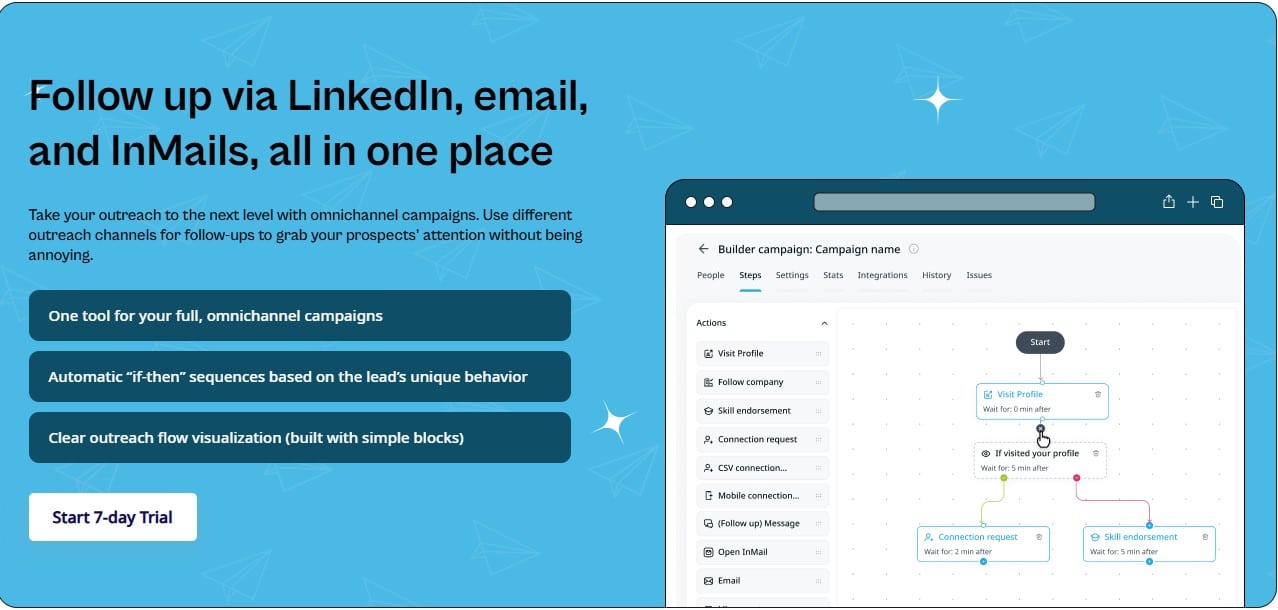
At Salesbread we love using Expandi to help us automate some LinkedIn lead generation steps.
Expandi is also really safe to use, and we have never been restricted or blocked by LinkedIn whilst using it.
It works by automating tasks on LinkedIn like sending connection requests and follow-up messages.
It’s important for users to use automation tools responsibly and that’s why we like Expandi because it has daily limits. We have never had a LinkedIn account blocked.
Pricing
There are 2 pricing tiers to choose from, but for $99 per month, you will receive 10+ campaign types and 7+ scraping approaches.
Quickmail
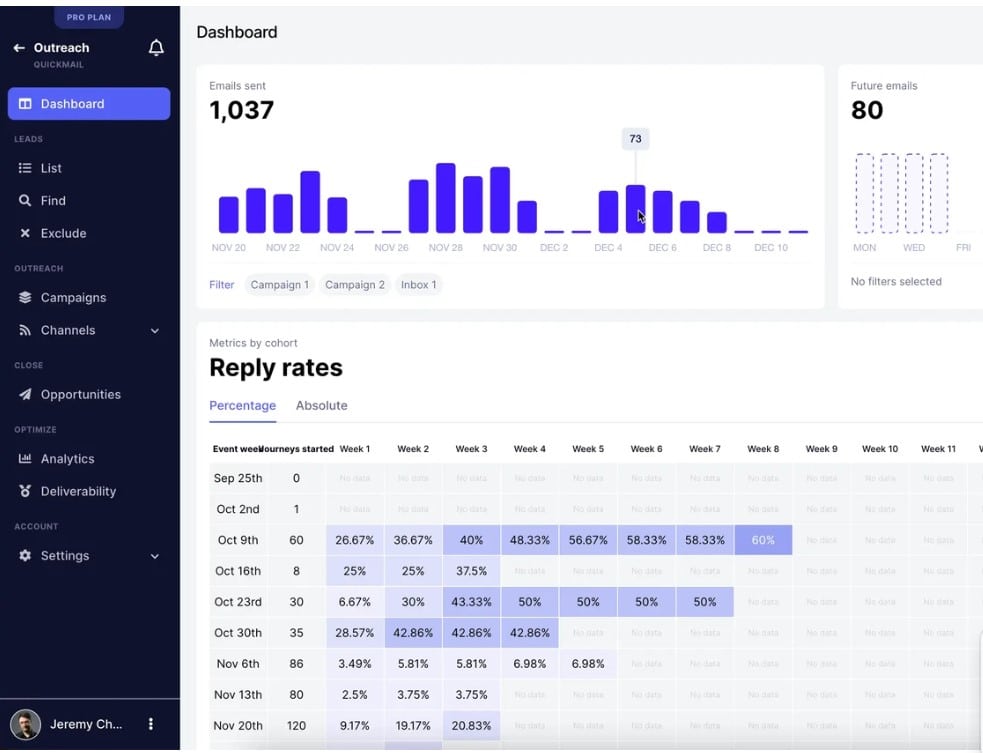
We also suggest using Quickmail to automate your email steps.
Quickmail is a tool designed to automate cold email campaigns, helping businesses and marketers streamline their outreach efforts.
It enables users to send personalized email sequences to multiple recipients and provides features like automated follow-ups, inbox rotation, A/B testing, and detailed analytics to track campaign performance and keep track of leads.
Pricing
Quickmaill offers various pricing tiers, but you can expect to pay between $49 – $129 per month for their single plans; And $399 – $799 per month for their agency plans.
Pipedrive
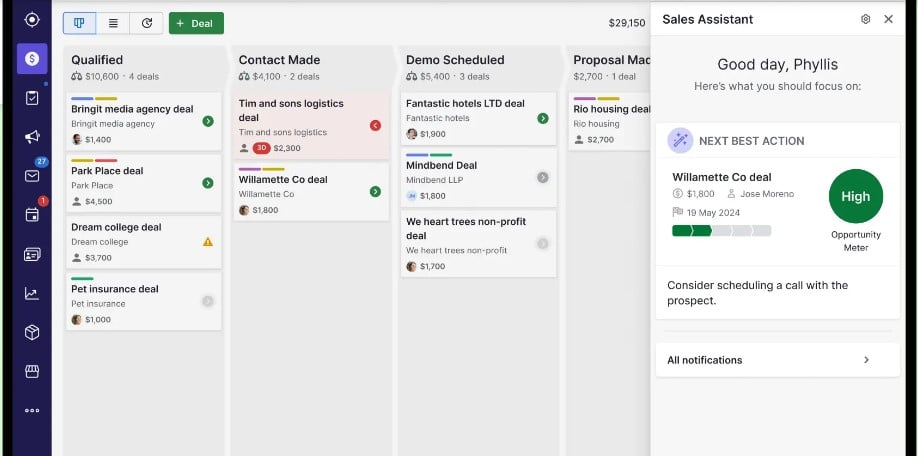
Pipedrive is a CRM and sales pipeline management tool with really good automation features.
With Pipedrive, you can automate repetitive tasks like sending follow-up emails, creating reminders, and updating deal statuses, which allows sales teams to focus more on high-priority leads and closing deals.
The tool’s customizable workflow automation enables users to set specific triggers and actions, such as following up after a certain number of days or sending personalized emails based on lead behavior.
Additionally, Pipedrive integrates with popular email and communication platforms, making it easy to track interactions and monitor the effectiveness of follow-ups, which can improve response rates and sales conversions.
This level of automation ensures that no lead slips through the cracks, providing a smoother experience for both the sales team and the customers.
Pricing
There are 5 pricing plans to choose from. The pricing starts at US$12 per seat, per month and works it way up to $79 per seat per month.
10. Try a phone call
If you already met up with a prospect, or they booked a Zoom meeting with you, but haven’t paid yet for your service after you sent them an invoice, we suggest giving them a call after 5 days.
You could just politely ask them if the timeline still works for them, if there’s anything else you could do to help, or if they have any concerns. Your phone is probably one of the most powerful sales tools you can use.
The caveat, though, is to use it wisely. Many prospects might never close, so don’t waste time calling these people.
Rather, spend your time closing sales leads that you know are an easy slam dunk.
11. Schedule & track follow-ups
Using tools to schedule and track lead follow-ups makes staying organized easy. This is why investing in CRM (Customer Relationship Management) software like HubSpot or Salesforce, or even simple tools like Trello or Google Sheets, can help.
You just enter the lead’s info and contact information, set reminders for follow-ups, and track where they are in your sales process. Some tools even automate follow-up emails or send you notifications so you never miss a chance to reconnect.
That way, no lead slips through the cracks.
Final Thoughts
Effective lead follow-up is an art form. By focusing on targeted, concise interactions, offering clear next steps, and showing real interest in their needs, you can transform brief “I’m interested” replies into engaged prospects, booked meetings, and successful sales.
If you’re looking for 1 sales qualified lead per day, reach out to us for a free 15-minute strategy session below.
